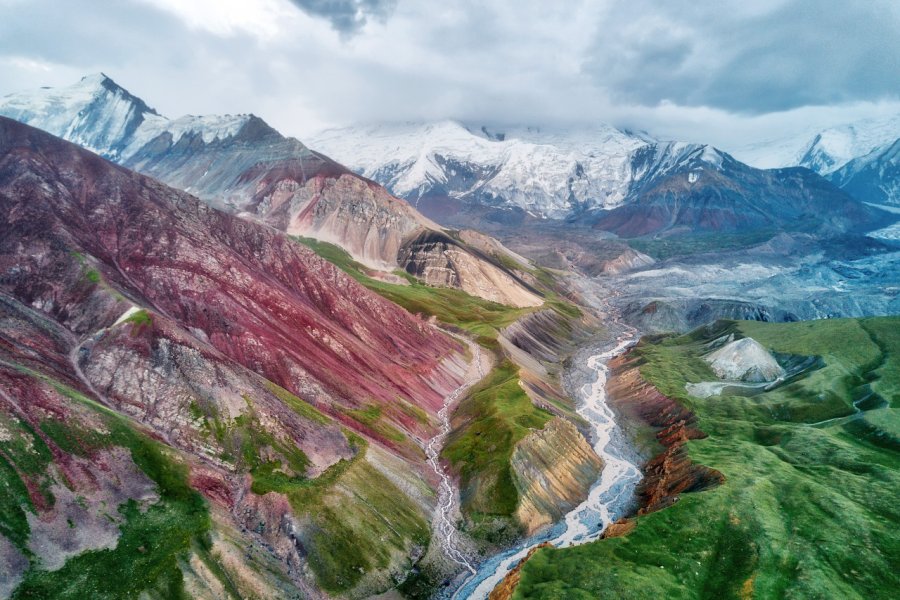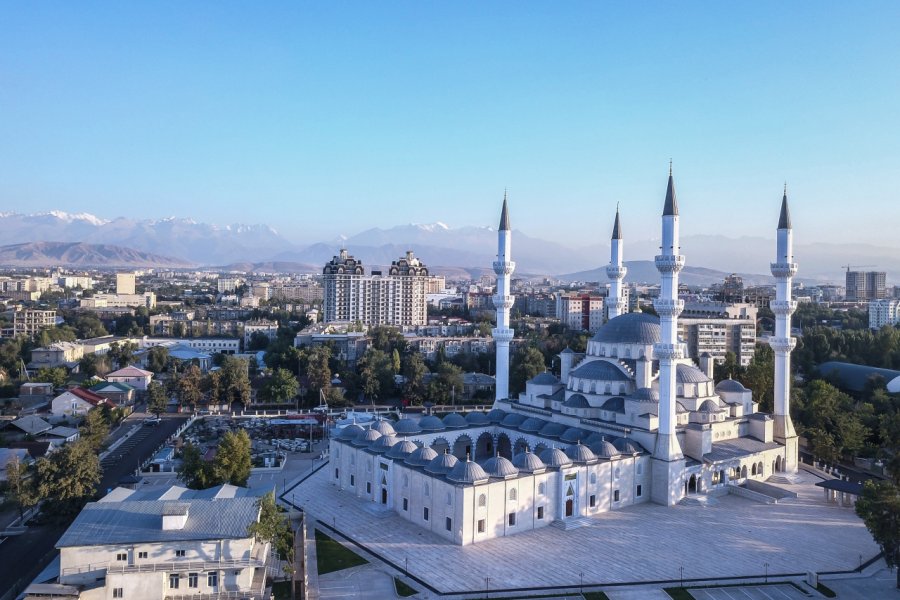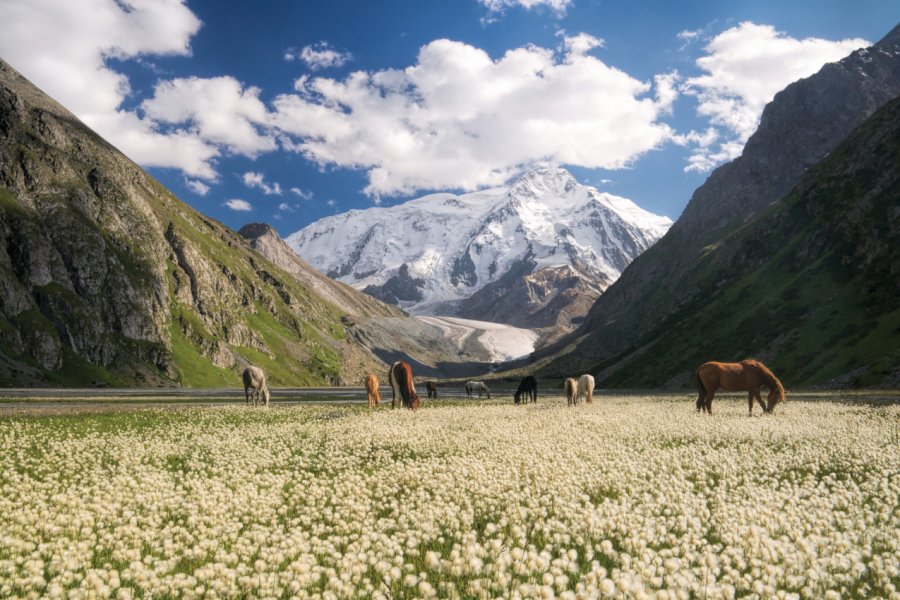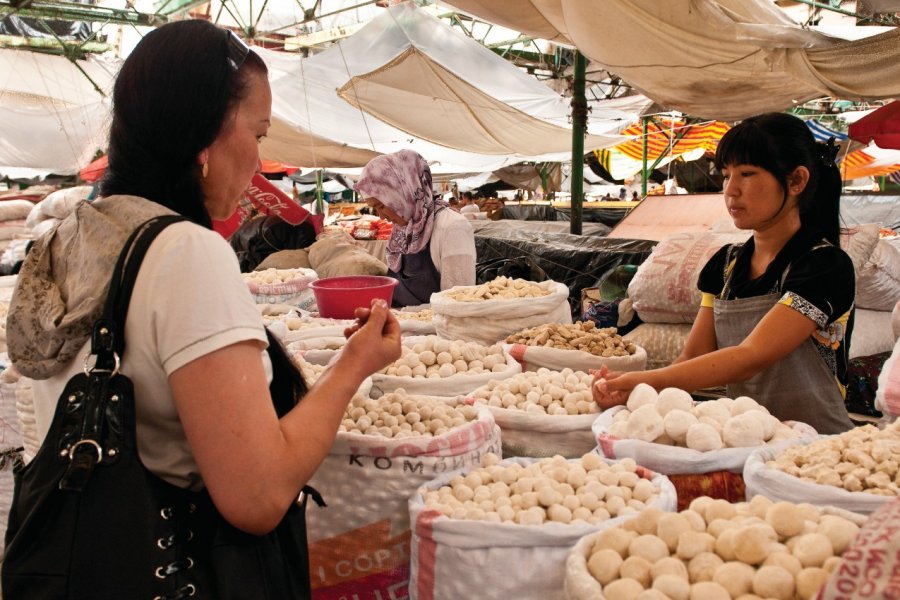Travel guide Kyrgyzstan
Halfway between the two ends of the mythical Silk Road, the ancient trade route once used by caravans between China and the Mediterranean, Kyrgyzstan is an unusual destination with sumptuous and impassive mountains. Familiar travellers to Central Asia, whether from Kazakhstan or Uzbekistan, will be surprised to discover a country with limited infrastructure, little tourist traffic, and where it is often necessary to travel by horseback if you move away from the few beaten tracks. The Kyrgyzstan tourist guide takes you to the heart of a nomadic and equestrian country, to the assault of the highest peaks in the world, like Khan Tengri, Peak Communism and Peak Lenin, where the inhabitants, speaking only Russian or Kyrgyz, continue to bring to life ancient traditions such as the oulak-tartych, a game of extreme violence in which riders compete for the possession of a goat's decapitated carcass, or even falcon hunting. In the east of the country, near Cholpon-Alta, there is the immense Issyk-Kul Alpine lake and its seaside resorts, while in the west, the Kyrgyz Ferghana Valley, mainly populated by Uzbeks, offers all the treasures of its bazaars, crafts and small mountain villages. A complete destination, in the heart of the Celestial Mountains, where your steps will take you on paths that are still deserted. Yes, the adventure is still possible!
What to see, what to do Kyrgyzstan?
-
Book an activity
-
Customized travel
- The most beautiful cities Kyrgyzstan
When to go Kyrgyzstan ?
When to go to Kyrgyzstan? The climate is extremely harsh due to the high mountains that cover the whole country, and the tourist season is particularly short. The best time to go to Kyrgyzstan is from July to August. Lake Song-Kul is thawed for less than a month at the bottom of this period. From October to April, snow clutters or blocks roads, makes mountains inaccessible, and all travel tedious and long. If you have no choice but to go away in the winter, take shoes with good insulating soles and warm clothes. The north of the country, between Bishkek and Lake Issyk-Kul remains passable even if it is not uncommon to see 40 cm of snow fall in one night. You can also connect the main cities such as Osh or Naryn, but don't expect to be able to venture into the mountains too much unless accompanied by a specially trained mountain guide. Even if the cold weather in altitude remains severe, the months of May and June as well as the month of September are also periods to consider for those seeking to know when to go to Kyrgyzstan. But in the event of early winter or late spring, some regions can maintain the same difficult conditions as in winter.
Travel Kyrgyzstan
-
Find a hotel
-
Car Rental
-
International e-SIM package
-
Find a local agency
La petite taille du pays et le nombre réduit de routes ne favorise pas la variété d'itinéraires pour partir à la découverte du Kirghizistan. En outre, la thématique sera toujours sensiblement la même où que vous alliez : randonner, monter à cheval, voir des lacs. oubliez les best of de musées ou les thématiques trop culturelles, le Kirghizistan est une destination nature, sauvage et sportive. La singularité de votre itinéraire dépendra donc entièrement du temps que vous consacrerez à la destination : plus long sera votre séjour, plus loin vous pourrez aller des sentiers battus et découvrir des régions encore plus reculées. Loin des infrastructures touristiques, vous vous rapprocherez d'une population hospitalière et attachante, prête à vous ouvrir les portes de leurs traditions et de leur culture, ce qui sera certainement le plus beau souvenir que vous aurez à ramener. Pour y parvenir, trois semaines semblent un minimum recommandable !
Find unique Stay Offers with our Partners
How to go Kyrgyzstan
How to go alone
On the side of large airlines, the average price of a round trip Europe-Bishkek air ticket varies from €600 to €800. That's what you'll find with Turkish Airlines, Aeroflot or Lufthansa. Recently, Pegasus Airlines Asia, Turkish's low-cost subsidiary, also serves Bishkek from Paris via Istanbul at around €500. This will finally bring down the prices of other companies! Remember to buy your tickets six months before departure!
How to go on a tour
Although not very touristic, Kyrgyzstan is on the program of some travel agencies and tour operators specialized in Central Asia. The only thing to do is to find the formula that suits you best: family vacations, trekking, honeymoon, self-tours... It is also possible to have a tailor-made tour, depending on what you like, all-inclusive or partially paid (combined plane + accommodation, for example).
How to get around
On the aircraft side, the number of domestic routes is limited by the obsolescence of airport infrastructure. All Kyrgyz airlines are blacklisted, except Pegasus Asia. We therefore prefer to take the bus or minibus. Shared taxis are also a quicker and more comfortable way to travel, especially useful for long journeys. On the train side, your only Kyrgyz experience will eventually be on the Moscow-Bishkek line.
Discover Kyrgyzstan
Kyrgyzstan is one of those destinations that make travelers, adventurers, nature lovers and a handful of mountaineers dream. But do we really know this timeless land of nomads? For a long time, Uzbekistan was the only tourist destination on the map, but now it's open for business two or three months a year, when the snows melt. To help you get to the heart of the matter, this chapter provides an overview of the history that has shaped Kyrgyzstan, its incredible cultural melting pot, its economic, social and ecological challenges, as well as its gastronomy, crafts and many natural assets: welcome to the land of nomads, trekking, mountaineering, yurts and its ever-welcoming inhabitants... We take a closer look at this magnificent, little-known destination, with its legendary hospitality and breathtaking landscapes!
Pictures and images Kyrgyzstan
The 12 keywords Kyrgyzstan
1. #Aksakal
The "white beards", those bearded old men who can be seen everywhere, chatting, playing dominoes or sipping tea in the shade, are emblematic of Central Asia, and still play an important role in social organization. The aksakal are the living memory, and their opinions still carry weight in local councils.
2. #Horse

The celestial horses of the Ferghana Valley are at the origin of the development of the Silk Road. They are the indispensable companions of nomadic warriors (and also of Chinese armies), and have enabled them to dominate the East since antiquity. A Kyrgyz proverb even states that "horses are man's wings".
3. #Hospitality
In Kyrgyzstan, nomadic tradition means that the guest is king. There's a saying that "if an unexpected guest arrives, it's a gift from God; if the guest is expected, it's a punishment from God". Hospitality is all the more frequent the further you are from the cities, and you're sure to enjoy the warmth of yurts in summer.
4. #Kalpak
The headdress worn by Kyrgyz men is different from the skullcaps seen in the rest of the region. This conical felt hat with rolled-up brims is usually white with black patterns. It's a symbol of the mountains, and the aksakal never part with it.
5. #Lake

Kyrgyzstan has beautiful high-altitude lakes, remnants of a vanished ocean where the Greek authors used to locate Atlantis. Around Lake Issyk Kul reigns in summer a typical seaside atmosphere ... with water at 18 ° C! More authentic, Song Kul with its turquoise waters reflecting the mountains remains the pearl of the country.
6. #Lenin
The country is one of the last where you can admire statues of Lenin. The largest are in Bishkek and Osh, but you'll also find them in Naryn and Karakol. As a sign of Kyrgyz friendship with Russia's "big brother", there's not a town that hasn't kept an avenue named after him, even after independence.
7. #Navrouz

Spring is celebrated on March 21 in Kyrgyzstan and throughout Central Asia. Navrouz means "new day" in Farsi. This festival, which symbolizes the awakening of nature, has its origins in Zoroastrianism, and remains one of the country's most important, giving rise to numerous festivities and ceremonies throughout the country.
8. #Oulak Tartych
What Kessel reader hasn't dreamed of attending the great ball of the nomadic horsemen? This game consists of several riders, sometimes hundreds of them, competing for a goat carcass and completing a predetermined course before bringing the carcass back to the "circle of justice". To achieve this, almost anything goes!
9. #Shyrdak

These felt carpets can be found as decoration in all yurts. It is THE Kyrgyz souvenir! Try to visit a workshop of manufacture before going to the purchase. You will thus be able to make you an idea of the techniques of manufacture and then why not to place order of the shyrdak decorated with the reasons and colors of your dreams..
10. #Thermal springs
Kyrgyzstan boasts many virtuous hot springs: in Cholpon-Ata, Karakol, Djalalabad... In these towns, the Russians built sanatoriums. Some of them have survived as witnesses of their time. Others, like those in Cholpon-Ata, have been renovated and are now highly prized by wealthy Kyrgyz, Russian and Kazakh families.
11. #Tunduk
The tunduk, a circular opening at the top of the yurt, consolidated by two rows of three interlocking pieces of wood and providing natural ventilation and lighting, has become a national emblem. It is featured on the Kyrgyz flag, and can also be recognized as an ornament on many graves in cemeteries.
12. #Yourte
A traditional nomadic dwelling, the yurt is a felt tent supported by a removable wooden frame. It's known as a ger, a name that originally referred not only to the yurt itself, but also to the place where it's set up and, by extension, to the nomads' homeland. It takes an experienced craftsman an average of 25 days to build a yurt.
You are from here, if...
Under the yurt, you sit on the west side for the men, on the east side for the women.
You keep your feet away from the food and eat sitting cross-legged, even if it means pushing the limits of your flexibility!
You always have small gifts (postcards, photos, samples...) to offer your guests.
You use your right hand to eat, serve tea or hold out your cup... And you avoid blowing your nose in public.
You avoid saying " salaam aleïkoum " when you wake up. In Kyrgyzstan, people only greet each other after morning ablutions.
You don't hesitate to make a toast if vodka is served, and you certainly don't drink if no toast has been made.
You accept without complaint when offered the choice morsel of mutton: the eye!
You don't leave the table without thanking God for the meal or at least joining hands before running them over your face, as your hosts will do.





























